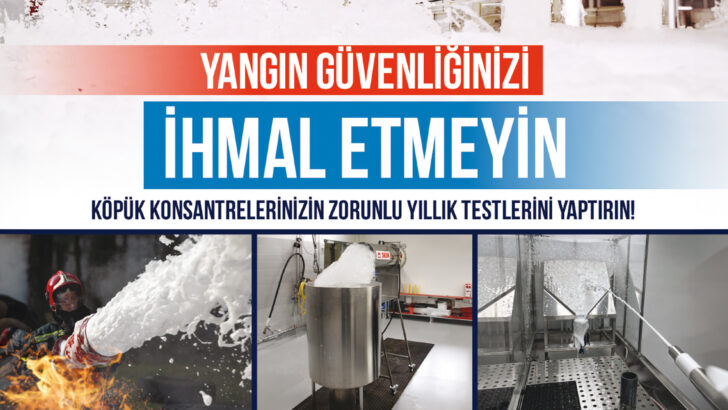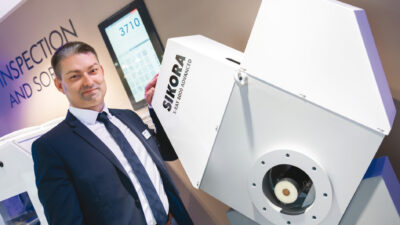EFFECTIS TESTS OF FOAM CONCENTRATES AND SYSTEMS USED IN FIREFIGHTING


Foam concentrates and systems used in firefighting play a critical role in protecting buildings and industrial facilities against fire risks. These systems, while having the ability to extinguish fires quickly and effectively, must be operated in compliance with specific standards to ensure maximum performance through regular maintenance and periodic tests.
Due to our Turkey’s membership in the European Customs Union, it is necessary to adhere to the requirements of European Norms (EN). According to EN 13565-2 standards, periodic tests of foam concentrates, and foam fire-fighting systems used in firefighting are mandatory. Similar quality tests are also required in NFPA 11, one of the internationally recognized standards.
In addition to complying with the requirements of manufacturers and installers, foam tests must be conducted by independent organizations.
Efectis Era Avrasya Laboratory offers a quality analysis service for any foam concentrate and system, regardless of production.
Importance of Foam Concentrate Quality:
Foam concentrates used in firefighting must have the correct concentrate quality. This is crucial in rapidly controlling and extinguishing fires. Therefore, foam concentrates and systems should be evaluated at regular intervals. The purpose of these tests is to ensure that the systems are functioning correctly and will provide the expected performance during a fire.
Why Periodical Foam Tests?
Even foam concentrates stored under the most appropriate conditions and of the highest quality can deteriorate. Foam concentrate degradation can occur for a variety of reasons, such as dilution, contamination, excessive heat, and excessive sedimentation.
Which Tests Should Be Conducted?
1. Commissioning Tests:
Commissioning tests of foam concentrates are conducted to ensure that fire extinguishing systems work correctly and can provide the expected performance. These tests are important for assessing the effectiveness of the concentrate system and, if necessary, taking corrective measures.
a. Visual Inspection:
Visual inspections must be conducted to ensure that fire extinguishing systems are installed correctly in accordance with specifications and design drawings. Additionally, it should be ensured that there are no leaks in the system when all valves are closed.
b. Pressure Tests:
Pressure levels in the system need to be checked. Pressures shall conform to the values declared by the manufacturer. To remove any foreign substances, piping should be rinsed at the maximum flow rate possible. All piping should be subjected to hydrostatic testing up to 1.5 times the maximum operating pressure.
c. System Testing:
Tests should be conducted to confirm the proper flow, proportioning, and distribution of foam concentrate. These tests assess foam properties, operating pressures, foam distribution, and the functional performance of valves and foam proportioners.
2. Periodic Tests:
Regular checks and maintenance are required to ensure the operational status of foam fire-fighting systems. These tests are conducted by foam test experts every six months or annually.
a. Semi-Annual Inspections
The following tests should be conducted every six months by foam system experts:
• Visual inspection of strainers.
• Functional testing of foam proportioners using water without foam concentrate (when specified by the manufacturer).
• Testing the free movement of all valves and mechanically operated components.
b. Annual Inspections
The following tests should be conducted annually by competent and trained foam laboratory personnel. Many of these tests are conducted in the laboratory due to temperature criteria, conditioning, or the need for a sterile environment. Samples should be taken by technical staff or foam experts from Efectis Era Avrasya in accordance with the sampling instructions and sent to foam laboratories in appropriate containers.
The following tests should be conducted to measure foam quality:
– Foam Type and Appearance: Evaluates the physical properties of foam concentrate. The structure, color, and homogeneity of the foam are observed to determine if there are any significant impurities, degradation, or separation in the foam.
– Specific Gravity: Observes whether the foam concentrate is diluted or overly concentrated by determining the weight of the concentrate per unit volume.
– pH Value: Determines the acidic or basic properties of the foam concentrate to help understand its corrosion potential.
– Sedimentation: Determines the number of solid particles in the foam concentrate. Excessive sediment can lead to blockages and serious problems in induction systems and other equipment.
– Spreading Coefficient: Foam concentrates formulated to create a watery film on the surface of some hydrocarbon liquids. The spreading coefficient is a measure of this ability to spread effectively on surfaces during a fire. The surface tension created by the laboratory to determine this.
– Viscosity: Measures the flowability of the foam concentrate. Liquids are classified as Newtonian or Non-Newtonian. Measurement methods for foam concentrates vary depending on the foam type. Low viscosity is desired in foam concentrates, as they have a thinner structure and flow more easily, spreading quickly during a fire and distributing effectively over a wide area. They also offer less resistance in the pipe and provide a more homogeneous distribution during the spraying process.
– Determination of Freezing Point: Determines the freezing point of foam concentrates to prevent them from losing their functionality at low temperatures.
– Accelerated Aging: This test allows for evaluating how the concentrate will be affected when stored for a long time or exposed to various environmental factors.
Quality tests as described above result in a report, which is reported as “Pass” or “Fail”. If the foam concentrate report does not pass quality control tests, it should be immediately replaced with foam concentrate that has passed fire testing according to the relevant section of TS EN 1568 by the same type suitable for use and approved by an authorized organization. If any foam concentrate sample is found to perform at the limit, small-scale fire tests shall be conducted in the laboratory.
c. Performance Tests
In addition to evaluating the physicochemical properties of foam concentrates, conducting performance tests shows us how effective the foam sample will be in extinguishing flammable liquid fires.
– Expansion Ratio and Drainage Time: The expansion ratio indicates how much the foam concentrate increases when mixed with water. This test is essential to ensure that the concentrate is mixed correctly and operates effectively within the fire extinguishing system. Drainage time indicates how the foam flows from the surface. This test assesses the foam’s effectiveness by evaluating its post-fire drainage time.
– Induction Test (for System Calibration): This test determines whether the fire extinguishing system is properly calibrated. Tests are conducted at maximum and minimum system design flow rates, including proportioning and related connection components. The accuracy of foam proportioning should be within the tolerance specified in TS EN 13565-1.
– Alcohol Tolerance Test: This test assesses whether the foam concentrate is effective against flammable liquids like alcohol. Alcohol can reduce the effectiveness of some foam concentrates.
– Small-Scale Fire Performance Test: This test simulates a real fire scenario and evaluates the effectiveness of the concentrate. In cases where quality tests indicate that a low-expansion foam concentrate sample performs at the limit, small-scale fire performance tests are conducted in the laboratory according to TS EN 1568-3 and TS EN 1568-4.
Additionally, induction tests for accurate foam extraction and system calibration should be performed. Finally, if foam quality tests indicate that a low-expansion foam concentrate sample is performing at the limit, small-scale fire tests should be conducted in the laboratory according to TS EN 1568-3 and TS EN 1568-4.
d. Flow Tests:
Flow tests are conducted to ensure that fire extinguishing systems are functioning correctly, there are no obstructions in nozzles, valves are working correctly, and foam has reached the required protection area.
FAQ:
– How long do the tests take?
The test durations can vary depending on the requested test type, the number of samples received, the laboratory’s testing workload, and conditioning periods.
Typically, tests are conducted within a maximum of 2 weeks after the end of the conditioning period for the sample sent to the laboratory.
– What if the foam fails?
As a first step, contact should be made with the foam manufacturer to obtain technical support.
In some cases, it is recommended to take a new sample from the foam container and retest it. The appropriate sample should be taken as directed by our laboratory.
If a retest request is made, abnormal results are evaluated, and a solution is sought.
– Is the concentration percentage tested?
We cannot test the percentage of foam concentrate. The mixing ratio should be listed on the foam storage container. It can also be found on the proportioner.
– What is the difference between the standard test and the proportioner test?
The standard test evaluates the quality of the foam itself, while the proportioner test evaluates the proportioning equipment.
– What types of foams are tested?
We can test every type of foam concentrate, including AFFF, ARAFFF, AR-FFFP, HI-EX, FP, Class A, FFFP, and F3.
– How often should I have my foams tested?
According to international standards (NFPA 11 and EN 13565-2), foam concentrates should be tested at least once a year.
– When can I receive the test report?
The test report is published within five business days from the completion of the test.




